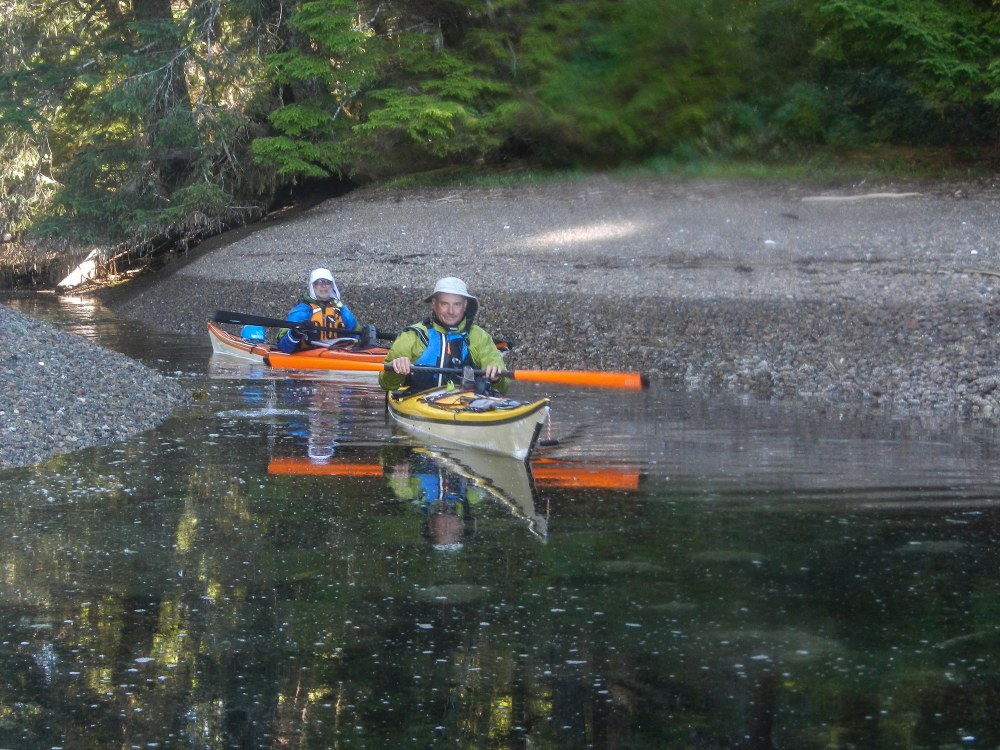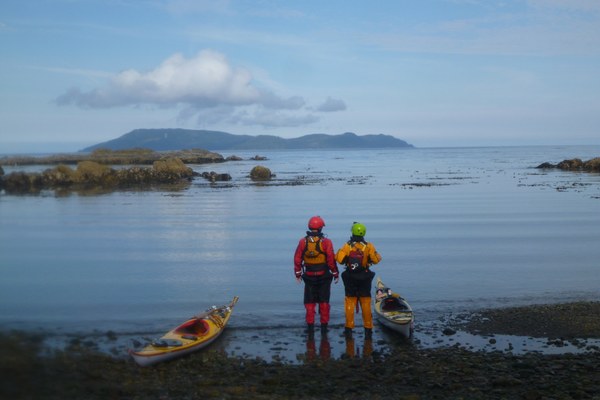
Tom Unger has been hiking, climbing, skiing, paddling, and sailing up and down the west coast for 25 years. He’s widely praised by students and participants for his outstanding communications, group facilitation, instruction, and collaborative leadership. In the summer of 2017, Tom led a two-week trip with The Mountaineers around Cape Scott with Barney Bernhard, Esther Ladwig, Marty Mayock, Charlie Michel, and Karen Cramer. In this interview, Tom discusses how he intentionally brought his group together around common goals, expectations, and trip styles.
Why was it important for you to do this trip to Cape Scott with The Mountaineers?
I like going to remote places. The feeling of being some place seldom travelled is very interesting and exciting. Cape Scott is a remote and beautiful area, with a lot of outer-coast paddling. Going around Cape Scott, on the north end of Vancouver Island is a significant rounding and I wanted to do the whole loop.
The common way to put together a trip like this is with a private group. But I thought, there’s probably people out there who I don’t know, who would love to go on this trip. As a Mountaineers trip, I could meet some people who I don’t know yet, and they might turn out to be great companions.
People are hesitant to run longer trips with people they don’t know because it can be difficult to get a skilled group with the right goals, expectations, and style. And that’s what I presented on last year at The Mountaineers Leadership Conference. I thought, I can use what I’ve learned about what goes wrong on trips, about how people come with mismatched goals, mismatched expectations, or different styles and don’t get along. I can use that to have more effective dialogues before the trip, to align ourselves, or to identify that we’re not in alignment.
Because it’s not like me asking a buddy, “Hey do you want to do this?” People have the ability to think about it for themselves; to decline and say, “No, I think maybe this isn’t the match for me,” or “Yes, this sounds like the type of trip I want to do this summer.” It seemed important to do it as a Mountaineers trip.
How did you screen the group and prepare for the trip?
My list of goals, expectations, style, and skills was a big part of the screening process. People could read my list and think about it, and decline to sign-up if it doesn’t sound like the right fit. The more information that I got out there, the more people were able to screen themselves.
The trip started at the end of July, but I pretty much had the group set by the end of January. I asked that the group commit to a day paddle at Deception Pass where we would practice skills, and paddling in dynamic water, and rescues. All I asked of them was this one day. But then we also scheduled another day to paddle from Washington Park [in Anacortes] to Friday Harbor, and everyone showed up for that, and then we scheduled a weekend to paddle at Hobuck [on the Washington coast]. It had been awhile since I had paddled in surf, and they wanted to get out there, too, and paddle their long boats in surf. The Hobuck trip was one of the best, as far as coming together as a group, because we spent several nights camping and eating together, and we did a couple of different paddles. It seemed like a lot to ask, but I might do that again if I’m scheduling an expeditionary type trip.
You spent a lot of time together, even before the trip. How did group dynamics change as you got to know one another?
A challenge brings the group together. On our first day, we were paddling into the wind and against current. We poked along the shoreline trying to stay out of the bad, contrary conditions. Eventually, we had to make a crossing, and I said if we try to paddle this crossing with wind and current pushing us back, then it’s going to be hard to go. I suggested we wait until the current shifts, and then we’ll have the wind coming against us but the current going with us. Well, that’s a classic set-up for really rough waves, but for some reason, they all agreed to do this. I told them we’re going to paddle along the shore until it looks like a good crossing, and we’ll cross together, to stay close. And if we can’t stay together, that’s a sign that we can’t really do this. Our solution will just be to turn around, run down wind and come back to the shore. We had an easy out.
It was white caps all over the place, waves washing across the deck occasionally, but we did great staying together. The crossing was maybe an hour-and-a-half, but my plan worked and we didn’t have to fight the conditions too much.
There was another kayak group at the camp when we arrived. They’d been brought out by a water taxi, and they hadn’t been able to do much kayaking because it was windy. Then they saw us pull in and they were amazed that not only were we paddling this, but we had crossed that channel which looked horrendous! I think for our group it was very encouraging that we made the crossing, and it actually wasn’t that hard for us. It gave us some confidence on day one, individually and as a group. No one abandoned anyone, no one got left behind, and everyone was able to paddle in rough conditions – and other kayakers were impressed! Everyone felt encouraged by that.
Thinking back on the trip today, several months later, what’s one part of the trip that still has you smiling?
After rounding Cape Scott, while paddling down the coast, Karen came up to me and said, “Tom, I’m not sure I understand what we’re doing. We have a really nice day today, calm conditions. This next section, Cape Russell, is supposed to be really rough. Why aren’t we going around it on this nice calm day? Why are we waiting until the winds and waves get bigger?” And I said, “Karen, there are two types of people who could be out here. One would be a group that just wants to paddle down the coast, and if we were that group, we would go around it today because it’s easy. But the other type of people would be out here to gain experience paddling on the outer coast. That group would camp here in this bay and wait until the sea kicked up, and then go around. And that’s what we’re going to do.” So we intentionally waited until conditions got a little worse, and then paddled down the coast to get some experience.
We went out that next day, and they were easily six foot waves, ocean swells, not breaking. It was not hard to paddle in at all, but you’d lose sight of people for a while, long enough to wonder.
“I remember, I was paddling with Karen, she was around here somewhere, wasn’t she? Oh there she is, yeah okay.”
This ended up being a great part of the trip. We paddled in big conditions for a while, and everyone got experience doing that. We were very successful in finding a protected place to land, and we had a very nice camp there. It was beautiful! I think everyone came back from this trip with increased confidence in their ability to paddle on the open coast in moderately rough conditions. Our goal of getting more experience paddling on the outer coast was very successful.
Is there anything you would have changed about the trip?
Before the trip we practiced the obvious rescues, paddling in surf, paddling as a group, landings and launchings – but after the trip, I realized that we never practiced how to use stoves, filter water, or set-up the bug tent. This trip was active, so our time in camp seemed to be full of camp chores. Not knowing how to do these things efficiently as a group, we got a little bit behind. Upfront, it would have been better to have gotten the camp systems down. It would have been a little smoother.
What would be your word of advice or recommendation to others who want to lead something similar in scope?
My advice is to think carefully about what your goals are. I made enjoying the trip and enjoying the other people a high priority, so I kept working to remember that. Identify clearly what your own personal goals are, and then have clear discussions with the participants to bring yourselves into alignment.
What’s on deck, are you planning any other big trips?
I was thinking about organizing a trip to go around the Brooks Peninsula, which is the next section south on Vancouver Island. The Brooks Peninsula is a big peninsula with rough conditions, so it is another known, difficult rounding. It’s another place I want to paddle, another coastline I want to paddle along. Maybe next summer!

Tom Unger will present on “Forming Compatible and Cohesive Groups” at this year’s Leadership Conference, scheduled for Saturday, December 2.
This article originally appeared in our Winter 2018 issue of Mountaineer Magazine. To view the original article in magazine form and read more stories from our publication, click here.
 Sara Ramsay
Sara Ramsay